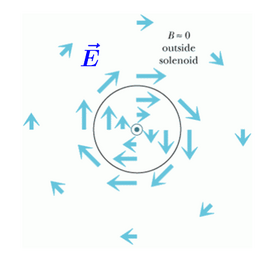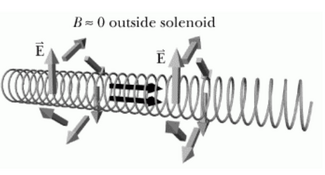Curly Electric Fields: Difference between revisions
No edit summary |
|||
| Line 24: | Line 24: | ||
==The Non-Coulomb Curly Electric Field== | ==The Non-Coulomb Curly Electric Field== | ||
''Read more about [non-coulomb electric fields]'' | ''Read more about [[non-coulomb electric fields]]'' | ||
====Coulomb Electric Field==== | ====Coulomb Electric Field==== | ||
| Line 32: | Line 32: | ||
===Effect on charges=== | ====Effect on charges==== | ||
The curly electric field has | The curly electric field has | ||
Revision as of 17:46, 1 December 2015
This topic is claimed by Miranda Fyfe.
Curly Electric Fields
In the case where current in a solenoid is constant and magnetic force is likewise constant in time, it can be observed that the magnetic and electric forces experienced by some moving charge outside the solenoid are essentially zero.
However, in the situation where current in the solenoid is changing and magnetic force is thereby time-varying, a curly electric field can be observed.


Proportionality
This electric field is proportional to the rate of change of the magnetic field (dB/dt).
Inside the solenoid
Curly electric field is proportional to distance from the solenoid axis, r.
Outside the solenoid
Curly electric field is proportional to 1/r, with the field decreasing as distance from the axis increases.
The Non-Coulomb Curly Electric Field
Read more about non-coulomb electric fields
Coulomb Electric Field
Non-Coulomb Electric Field
Effect on charges
The curly electric field has